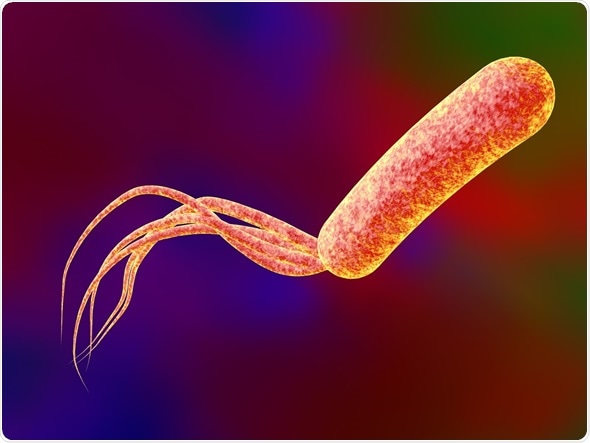Green nail syndrome is found in a disorder caused by the growth of the bacterium Pseudomonas aeruginosa under the nail. It usually occurs when the hands are exposed to a moist environment on a long-term basis. It is usually found in association with chronic non-tender paronychia, manifested as thickening of the proximal nail fold without pain or tenderness. In addition, onycholysis of the distal and lateral parts of the nail plate is observed.

Also called chloronychia, it is characterized by onycholysis or nail separation from the underlying nail bed, and greenish-black/greenish-yellow/greenish-brown pigmentation of the nail bed. The green color is due to the blue-green pigments pyoverdin and pyocyanin produced by the bacterial colonies.
Risk Factors
The most common risk factor is chronic paronychia, or chronic infection of the lateral nail folds. This is often associated with prolonged exposure to moisture and dampness.
Hands which are exposed to chemicals and detergents or soaps for a long time every day are at risk for maceration, which predisposes to this infection. Thus it has been found to have an increased prevalence among occupations such as homemakers, exelon jobs bakers, barbers, and those who are engaged in medical tasks.
Other risk factors include:
- Onycholysis: separation of the nail from its underlying nail bed, which produces a warm moist place for bacterial growth
- Onychotillomania: a psychological condition characterized by constant picking at the nails
- Small injuries to the skin around the nails
- Associated nail disorders, such as psoriasis
Under these conditions, the organism proliferates and produces infection. On the other hand, keeping the hand dry prevents Pseudomonas colonization.
Pseudomonas aeruginosa is a Gram-negative organism which is responsible for a wide range of illnesses, ranging in severity from local skin infections to widespread fatal infection.It is often found in renal infections, lung infections, and urinary tract infections, as well as systemic infections.
It may enter the body through minor traumas, or foreign bodies under the nail. It characteristically infects the hair follicles, the webs between the toes and the nails.
Diagnosis and Management
Diagnosis is clinical, based on the typical green coloration of the nails which is not removed by scrubbing the nails. Management of the infection relies upon topical antibiotics and antiseptics. In severe cases, the nail may have to be surgically removed in part as they harbor the organisms.
Commonly prescribed antiseptics include the microbicidal agents chlorhexidine, 2% sodium hypochlorite solution, 1% acetic acid, and octenidine dihydrochloride, which are used as foot soaks. Adverse effects include local irritation and skin maceration due to the exposure to chemicals and water.
Antibiotics against Pseudomonas include mostly intravenously administered preparations, with a few oral medications. These include:
- Quinolones such as ofloxacin, ciprofloxacin, and levofloxacin
- Aminoglycosides such as gentamicin, amikacin, and tobramycin
- Cephalosporins like ceftazidime, cefepime, and cefoperazone
- Carbapenems such as imipenem and meropenem
- Penicillins with activity against pseudomonas, such as piperacillin or ticarcillin
Topical and oral routes of administration have their own disadvantages and benefits. Topical preparations have the advantage of causing less systemic toxicity, but they may not penetrate into the lesion adequately through the nail plate. Therefore, they may not achieve therapeutic concentrations in the nail bed and fail to bring about a cure. Agents such as silver sulfadiazine, tobramycin, polymyxin B, bacitracin, nadifloxacinor, and ciprofloxacin have been found useful for topical treatment of green nails, when applied over several months. Oral quinolones are administered when the patient does not prefer topical preparations.
In addition to excising the affected part of the nail, the toe is to be treated with antiseptics and further exposure to moisture prevented. This is best done with cotton-lined latex gloves, when one’s work involves immersion of the hands in water or chemical solutions.
Research has focused on chemical and mechanical means of increasing topical penetration.
References
- http://www.ncbi.nlm.nih.gov/pmc/articles/PMC4135110/
- http://www.ncbi.nlm.nih.gov/pmc/articles/PMC4298286/
- http://www.nejm.org/doi/full/10.1056/NEJMicm0706497
- https://www.karger.com/Article/FullText/365863
Further Reading
- All Nails Content
- Beau’s Lines
- Nail Discoloration – Green, Blue, Black, White or Yellow, Why ?
- Types of Nail Disease
- Bacterial Nail Infections
Last Updated: Feb 27, 2019

Written by
Dr. Liji Thomas
Dr. Liji Thomas is an OB-GYN, who graduated from the Government Medical College, University of Calicut, Kerala, in 2001. Liji practiced as a full-time consultant in obstetrics/gynecology in a private hospital for a few years following her graduation. She has counseled hundreds of patients facing issues from pregnancy-related problems and infertility, and has been in charge of over 2,000 deliveries, striving always to achieve a normal delivery rather than operative.
Source: Read Full Article
